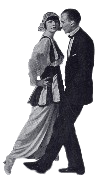 |
ROUND DANCING — CHOREOGRAPHED BALLROOMEDUCATIONAL ARTICLESMAJOR SECTIONS: Figures | Articles | Links | Alph. Index | Search | Home |
|
|
American Tangoby Harold & Meredith Sears Do you tango? It’s not a simple question. We have International or English Tango, with its disciplined, sharp, and rapid footwork. We have Argentine Tango, smooth and languorous, with sensual leg sweeps, leg crawls, swivels, locks, hooks, kicks, and flicks. And we have American Tango, which is said to contain the best features of the other two. American Tango steps are certainly less intricate than Argentine, and American Tango feels slower than International. Where International Tango emphasizes the use of quick steps and uses slow counts for contrast, American Tango uses more slow steps and uses the quicks for contrast. Tango Mannita is a classic American Tango, written by Manning & Nita Smith over 40 years ago. It was the first tango that we ever learned, and we still dance it today. It is built around four different variations on the American Tango Basic: walk two and Tango Draw (slow, slow, quick, quick, slow). In this dance, we run, rock & recover, corte & recover. There is an Outside Swivel and a Serpiente. The question above, “Do you tango?” might be complex; but thinking of American Tango, the answer can be simple: “Yes, I do!”But what are some of the characteristics that make Tango distinct? When we are in closed position, the hold is close, and the man is perhaps more in control than in Two Step or Foxtrot. His right wrist should be placed on the woman's left shoulder blade, the fingers and thumb together and pointing down her back toward the floor. Her left arm wraps around his right arm and the edge of her hand and forefinger presses against the lower side of his upper arm. She might try to lock her left thumb into his right armpit. Bodies are offset to the left so that left legs can swing freely past each other. She is well into his right arm, but we are close, with her right hipbone tucked firmly into the pocket of his right hip. We glue ourselves together and dance as one, our trail feet stepping well between those of our partner. But keep your torsos up and proud. Look left and think tall. Most steps are staccato. In other Smooth rhythms, we use the whole slow count to take the step. Movement flows steadily from one beat to the next. In Tango, we take the step more sharply, perhaps on the first beat of a slow or the first half of a quick, and then we hold the rest of the count. Place each foot and then stop; step and stop. There is no flow, no flight, no sway. Be a great jungle cat carefully stalking its prey. In Tango, we walk with a little right-side lead. The man steps forward on the outside of the left foot and rolls to the inside edge, on the inside of the right foot and rolls to the outside edge. The steps are a little bit crab-wise and curved a little to the left. Walk heel to toe, skimming the floor. Tango is sometimes described as the "Groucho Marx" dance because we flex our knees, and we stay down there as we move. However, you do not have to be way down. Only maintain whatever degree of flex that you choose—there is no rise and fall. And above all, if you happen to think of Groucho, do not think too much of silliness. Tango is mostly serious. You want to conjure up feelings of pride and passion. Put some controlled intensity into those fans of the leg, those dips and lunges. At the end of a count, when you are frozen in stillness, it is because you feel so strongly that you can do nothing else.
This article was published in the Washington Area Square Dancers Cooperative Association (WASCA) Calls 'n' Cues, April 2008; reprinted in Around Rounds, RDAV, Australia, October/December 2008; and DRDC Newsletter, December 2014/January 2015.
If you would like to read other articles on dance position, technique, styling, and specific dance rhythms, you may visit the article TOC. If you are not a member of DRDC, do consider joining. The group sponsors triquarterly weekends with great dancing and teaching, and the newsletter is one of the most informative available. Past DRDC Educational Articles archived here. Go beyond this site. Find other references on our Sources and Links pages.
|
 |
|
|